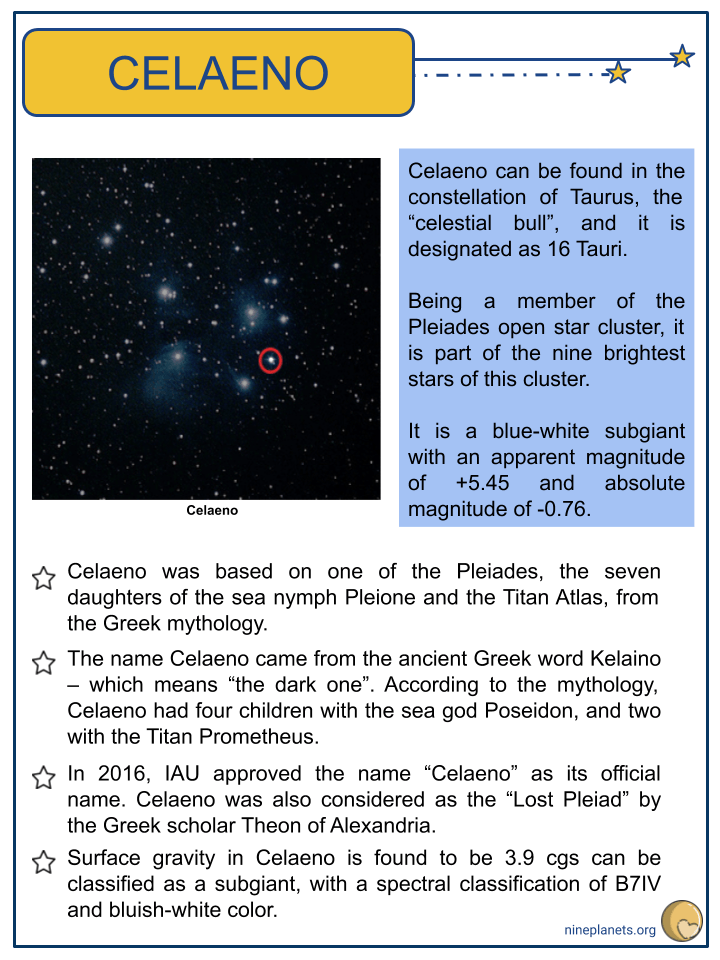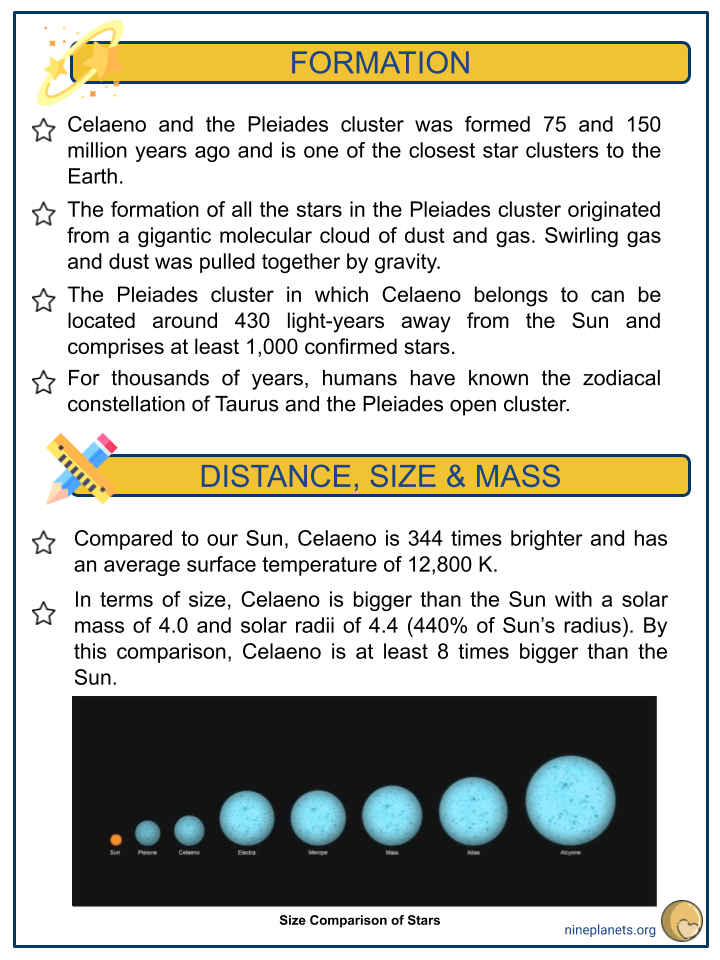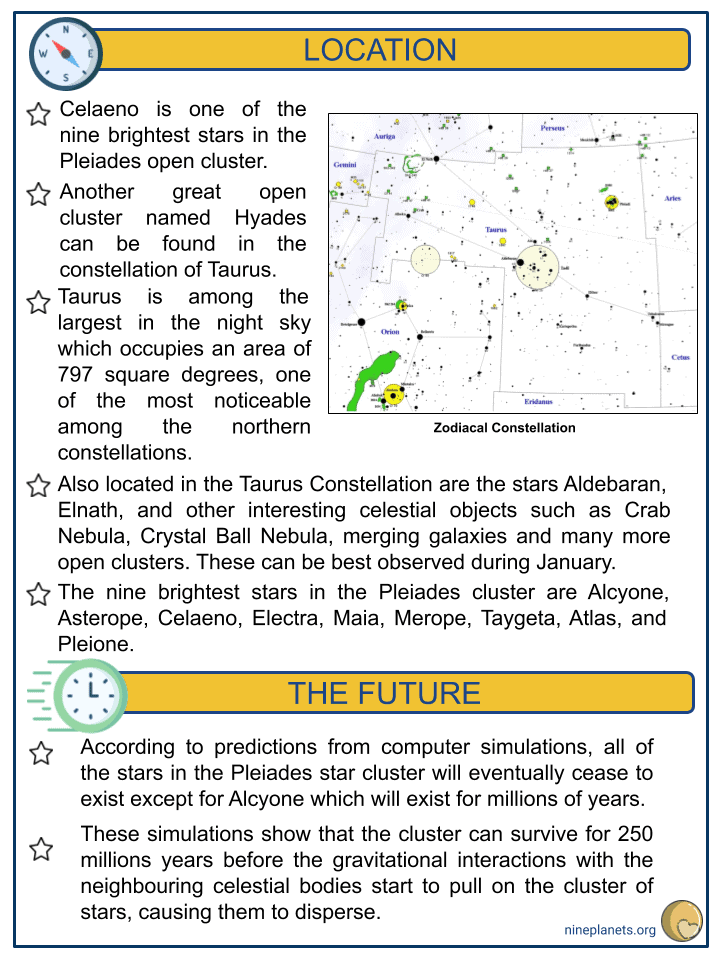Download Celaeno (Star) Worksheets
Click the button below to get instant access to these premium worksheets for use in the classroom or at a home.

This worksheet can be edited by Premium members using the free Google Slides online software. Click the Edit button above to get started.
Download free sample
Not ready to purchase a subscription yet? Click here to download a FREE sample of this worksheet pack.
Resource Examples
Click any of the example images below to view a larger version.




Key Facts & Information
- Celaeno can be found in the constellation of Taurus, the “celestial bull”, and it is designated as 16 Tauri.
- Being a member of the Pleiades open star cluster, it is part of the nine brightest stars of this cluster.
- It is a blue-white subgiant with an apparent magnitude of +5.45 and absolute magnitude of -0.76.
- Celaeno was based on one of the Pleiades, the seven daughters of the sea nymph Pleione and the Titan Atlas, from the Greek mythology.
- The name Celaeno came from the ancient Greek word Kelaino – which means “the dark one”. According to the mythology, Celaeno had four children with the sea god Poseidon, and two with the Titan Prometheus.
- In 2016, IAU approved the name “Celaeno” as its official name. Celaeno was also considered as the “Lost Pleiad” by the Greek scholar Theon of Alexandria.
- Surface gravity in Celaeno is found to be 3.9 cgs can be classified as a subgiant, with a spectral classification of B7IV and bluish-white color.
Formation
- Celaeno and the Pleiades cluster was formed 75 and 150 million years ago and is one of the closest star clusters to the Earth.
- The formation of all the stars in the Pleiades cluster originated from a gigantic molecular cloud of dust and gas. Swirling gas and dust was pulled together by gravity.
- The Pleiades cluster in which Celaeno belongs to can be located around 430 light-years away from the Sun and comprises at least 1,000 confirmed stars.
- For thousands of years, humans have known the zodiacal constellation of Taurus and the Pleiades open cluster.
Distance, Size & Mass
- Compared to our Sun, Celaeno is 344 times brighter and has an average surface temperature of 12,800 K.
- In terms of size, Celaeno is bigger than the Sun with a solar mass of 4.0 and solar radii of 4.4 (440% of Sun’s radius). By this comparison, Celaeno is at least 8 times bigger than the Sun.
Location
- Celaeno is one of the nine brightest stars in the Pleiades open cluster.
- Another great open cluster named Hyades can be found in the constellation of Taurus.
- Taurus is among the largest in the night sky which occupies an area of 797 square degrees, one of the most noticeable among the northern constellations.
- Also located in the Taurus Constellation are the stars Aldebaran, Elnath, and other interesting celestial objects such as Crab Nebula, Crystal Ball Nebula, merging galaxies and many more open clusters. These can be best observed during January.
- The nine brightest stars in the Pleiades cluster are Alcyone, Asterope, Celaeno, Electra, Maia, Merope, Taygeta, Atlas, and Pleione.
The Future
- According to predictions from computer simulations, all of the stars in the Pleiades star cluster will eventually cease to exist except for Alcyone which will exist for millions of years.
- These simulations show that the cluster can survive for 250 millions years before the gravitational interactions with the neighbouring celestial bodies start to pull on the cluster of stars, causing them to disperse.
Pleiades Members
- Celaeno is one of the nine stars in the Pleiades cluster.
- This cluster is one of the closest clusters to Earth.
- It is also one of the brightest clusters in the vicinity.
- It is very bright and easy to find.
- You may also find this cluster using the Orion’s Belt. Stars composing the Orion’s Belt are Alnitak, Alnilam, and Mintaka.
- Pleiades cluster is also called Messier 45. Stars in this cluster are made formed between 75 to 150 million years ago.
- All these stars are 444 light-years away from each other.
- These stars are most famous and documented stars. They are named after Greek mythology about the Seven sisters and their parents.
- The story depicts the story of seven sisters who caught the eye of Orion who is a giant huntsman. Their father, Atlas, was condemned to carry the heavens on his shoulders due to his fights against other gods. Orion then continued to pursue his daughters.
- The Greek god, Zeus, stepped in and transformed the sisters into doves then eventually made them into stars to console their father. Even if they became stars, Orion can still be seen pursuing the sisters being depicted by the Orion’s Belt.
Did You Know?
- One of the US Navy Crater cargo ships was named after Celaeno. This is called USS Celeno (AK-76).
- It is said that the Pleiades cluster was formed from a contact configuration that resembled the Orion Nebula.
- Pleiades cluster has been famous since ancient times throughout the world. One of the earliest discovery of this cluster and its stars is from the Nebra Sky Disk. This is a Bronze Age artifact uncovered in Germany dating from 1,600 BCE.
- There are many famous and ancient texts that mentioned the cluster. Such books are Homer’s Iliad and Odyssey, Hesiod’s Works and Days, the Bible, the ancient Egyptian Calendar of Lucky and Unlucky Days, and the Japanese Kojiki, which is an account of ancient matters.
- In the Japanese Kojiki, Pleiades cluster is the Musturaboshi which means six stars. In the modern Japan, this cluster is known as Subaru. This is the same name used by the famous automobile company which shows the six brightest stars in the logo.
- In 1610, one of the first telescopic observations was conducted on the Pleiades cluster. It was done by Galileo Galilei. He observed the bright stars and the cluster. It is noted that he may be the first one to do this.